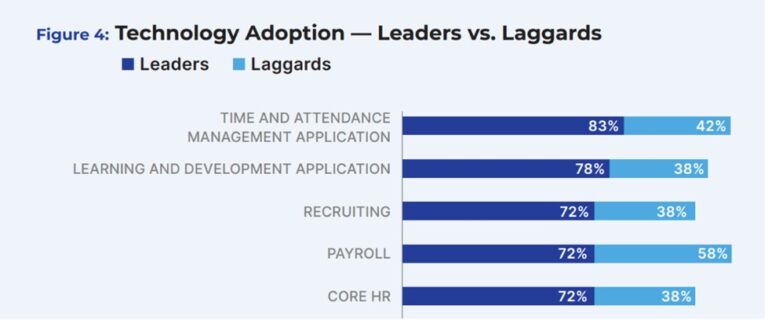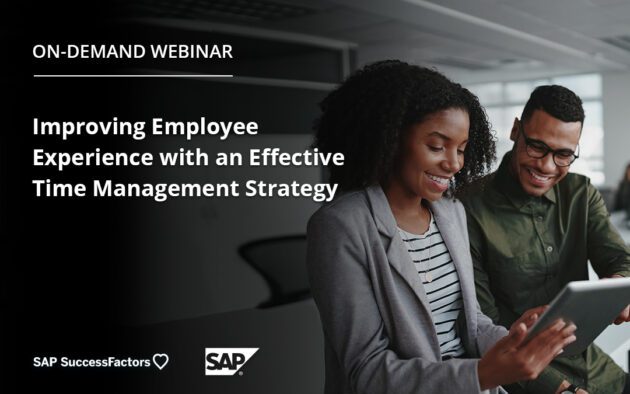The SAPinsider HCM and SAP S/4HANA Benchmark Report offers valuable insights into future strategies and tools for the workforce. As the work landscape evolves, it’s vital to shift from traditional human capital management (HCM) systems to human experience management (HXM) to remain relevant in the digital era and enhance employee experience and engagement—especially for deskless workers.
Leaders who have embraced HXM recognize the value of advanced time and attendance solutions like SAP Time and Attendance Management by WorkForce Software. Integrating cloud-based HXM systems with foundational tools, such as time and attendance management, is a game-changer that offers tangible ROI.
The SAPinsider HCM and SAP S/4HANA Benchmark Report
This report emphasizes digital shifts, time management’s pivotal role, and evolving compliance needs in modern workforce strategies.
“Time and attendance management is the only HR technology to attain over 80% adoption rate, demonstrating its critical role in meeting the requirements of deskless workers and providing streamlined experiences. SAP Time and Attendance Management by WorkForce Software, an SAP Solution Extension, is a modern workforce management solutions with a proven track record of delivering ROI. It facilitates workforce visibility and promotes better employee experience and engagement, which are the principal drivers of HXM system adoption.”

In an increasingly technology-driven landscape, quickly securing skilled personnel during operational and supply chain challenges has become a top priority. Organizations aiming for high employee engagement and retention recognize the value of state-of-the-art time and attendance features as essential to their HXM strategies. With an adoption rate of over 80% and industry leaders emphasizing the critical role of adapting to changing compliance needs, it’s clear that time and attendance systems are fundamental to modern workforce management and an integral component within an HXM framework.
Top 5 Factors Separating Leaders from Laggards
in Workforce Management
Time and Attendance: Industry leaders are quick to adopt comprehensive time and attendance systems, which play an integral role in their HXM strategies. On the other hand, laggards tend to overlook this aspect, resulting in inefficiencies and compliance risks.
Compliance: Leaders in the industry proactively adapt to new compliance regulations, ensuring that their time and attendance systems are always up to date. Conversely, laggards tend to react to changes, putting themselves at risk of non-compliance penalties.
Efficiency: High-performing organizations streamline their operations by using time and attendance data to optimize scheduling, minimize overtime, and reduce labor costs. Those falling behind miss out on the benefits of these practices, ultimately leading to operational inefficiencies.
Employee Experience: Progressive organizations consider their time and attendance systems to be a tool for enhancing employee engagement and satisfaction, thereby improving employee retention. However, laggards neglect this aspect, resulting in a disengaged workforce and higher turnover rates.
Communication: Effective communication is a key characteristic of industry leaders. They leverage their time and attendance systems to facilitate transparent communication between management and employees, particularly concerning scheduling and time-off requests. Contrarywise, laggards often suffer from poor communication, potentially leading to misunderstandings and decreased morale.
Next Steps on Your HXM Adventure
Reflect and Adapt: Evaluate your existing human capital management (HCM) methodologies and consider transitioning to human experience management (HXM) for a unified employee data view. Integrating insights from both desked and deskless workers can enhance decision-making, foster inclusivity, and boost engagement and productivity.
Make ROI-centric Investments: Align your financial resources with systems that consistently deliver on employee experience. Investing in advanced systems addresses pain points and yields substantial ROI.
Stay Aligned with Compliance: In an evolving compliance landscape, adapt your HXM strategies to ensure that desked and deskless workers operate within guidelines. Maintaining compliance is both challenging and necessary.
Embrace and Overcome HXM Challenges: Transitioning to a holistic view of employees comes with hurdles. Overcome challenges by creating structured plans, setting clear priorities, and moving forward with determination and confidence.
Prioritize Employee Experience: Enrich the employee experience by modernizing HR processes, attracting top-tier talent, and retaining star performers. Offering modern tools and a seamless experience for desked and deskless workers fosters a culture of engagement and commitment.
Every organization, from leaders to laggards, shares the common goals of refining their HR strategies, cultivating a dynamic work environment, and elevating business performance. The transition to HXM Human Experience Management (HXM) is more than a shift in tools or systems—it represents a paradigm change in how businesses interact with their workforce. Embracing comprehensive solutions, such as SAP Time and Attendance Management by WorkForce Software, and committing to an HXM approach unlocks unparalleled employee engagement, streamlined operations, and sustained growth. It’s time for organizations to confidently step into the future, fostering an inclusive and efficient workplace for all.
Dive deeper into the SAPinsider HCM and SAP S/4HANA Benchmark Report, and create a workforce strategy tailored to your unique needs.



